





is publication is a direct result of discussion supported by a motion at the 2022 BCAA Annual General Meeting. Members in attendance voted to move forward with a breeder directory that would share advertising and reader content for both purebred and commercial breeders of Angus cattle as well as for their local agriculture-based business trading partners.
e committee is proud of this rst-time production, and are hopeful that as you scan through the pages you feel the advertising and cattle industry related articles are relevant and informative.
I wish to extend appreciation to the Canadian Angus Association for their support in providing association program content relative to both the purebred and commercial cattle sectors.
e BCAA Board of Directors understands:
- e need to improve and increase relationships with provincial and national association members including Angus in uence commercial farmers and ranchers, through breed promotion and awareness.
- Fostering pro tability for commercial Angus in uence cow calf producers and feeders alike, brings value to your breed association.
We feel this directory serves as a valuable tool in that regard. I sincerely wish to thank BCAA committee members responsible for the production of this directory / handbook project: Robyn Mumford (Chair), Taylor Maciborsky, Adrienne Dickson, Joanne Cook, and Bob Miller (Observer).
BCAA Mission Statement – to promote the Angus breed consisting of Black and Red Angus cattle. To provide support, integrity and leadership for BC Angus Association members and BC Junior Angus Association members. To enhance and promote Angus in uence growth for all sectors of the beef cattle and beef production in British Columbia.
ank you again to all of the farm and ranch operations for their continued support in using BC Angus genetics within their purebred and commercial herds.
Success starts here. Ch rs,
e British Columbia Angus Association (BCAA) is a non-pro t organization and is a regional a liate of the Canadian Angus Association.
Members can bene t from eld days, awards, marketing opportunities and educational resources. e Junior program is also thriving in British Columbia, providing scholarships and extracurricular activities for youth.
e British Columbia Angus Association represents Angus breeders and Canadian Angus Association members within the province of British Columbia.
e BCAA seeks to unite, foster, and protect the interests of the Angus breed provincially as well as provide resources to breeders and commercial producers.
e BCAA is run by a volunteer board of directors. e board meets every few months to oversee the organization and plan activities. Volunteers are always welcome! Our AGM is held annually in September.
At the time of writing the British Columbia Angus Association is comprised of a President, Vice President, and eight directors. e Association also has a Canadian Angus Director and a Canadian Junior Angus Director who represent BC at a national level. As an Association, we try to have a representative that attends as many shows and sales as possible throughout the year.
e BCAA takes a lead role in organizing Angus events in British Columbia, participates in industry events, trade shows and conferences, hosts member networking and educational activities and promotes the breed in print and online through our website and social media.
e British Columbia Angus Association Board of Directors are here to help. Whether you’re new to raising Angus cattle or are already an established breeder, the Board is happy to assist you in building a strong operation.

Please visit our website at www.bcangus.ca or the BC Angus Association Facebook Page.
Our email address is bcangusassociation@gmail.com.

A long standing answer to this question has been “A good bull is worth the value of three to ve calves he sires” – depending on age, weight and current market value of the steer calves. Many believe this is a good rule of thumb to follow, which may lead to doing a little math, such as:
Current 2023:
600 lb weaned steer calves @ 3.50 / lb for a value of $2100 per head
• erefore using this formula – the answer to what one should pay for their next bull is somewhere between $6300 and $10,500
• Using four steer calves as an average with current market prices = $2100 x 4 = $8400
• 900 lb yearling steers @ $2.95 / lb = $2655 x 3 = $7965
So in the current market, a good bull is worth somewhere between $6300 - $10,500.to a good commercial cattle operation. Where exactly in that range, depends on your operations marketing plan and the market conditions at that time. In some cases, old rules of thumb still work or at least gives one a starting point.

As you prepare for the breeding season - cow owners before turning out bulls need to think about bull to female ratios. A conservative expectation of the number of cows we should expect bulls to cover in a de ned breeding season is;
- Bulls under 15 months of age = 10-12 females
- Bulls 15 - 18 months of age = 12-18 females
- Bulls 18 - 24 months of age = 18-25 females
- Bulls over 24 months of age = 25-40 females
Bulls provide the biggest proportion of calf crop genetics, so it is important to select a herd sire that can produce desired o spring.
Breeders of purebred cattle may consider the following basics when selecting their next herd sire or junior herd sire; pedigree, physical appearance, breeding evaluation, disposition and performance records (EPD’s).
Pedigree – is up to the individual as to what genetics that particular operation desires or has had previous success using. ere comes a time in larger purebred operations when “Outcross Genetics” are considered as an option.
Physical Appearance – one of the rst things when selecting your next herd bull is structural correctness. Without structural correctness, a bull will not perform nor last as long as expected. A herd bull should have a well-structured shoulder. Hind quarter structural correctness includes a slight slope from hooks to the pins with an imaginary line from the hook through the sti e.
Herd bulls should look masculine, thick through the middle and their hind quarters when viewed from behind. A strong, wide, at top is an indicator of good muscling.
Reproductive evaluation – includes a breeding soundness examination, which is used to help measure the potential sexual performance of a bull. When buying a bull, request the results of a breeding soundness examination as well. It is a good management practice to test all your herd bulls annually prior to the breeding season.
A bull can rank high in a breeding soundness exam, but if he lacks in libido, the animal will not have the ambition to settle cows. Although there is no real practical way to estimate a bulls potential mating ability, it is important to observe him breeding prior to turn out.
A breeding soundness evaluation includes, examination of reproductive organs, measurement of scrotal circumference and evaluation of semen.
A physical evaluation should include structure, feet, eyes, mouth, body score and ability to travel.
It is not a sign of poor management or bad genetics if a bull loses body condition during the breeding season. e good bulls should be working hard. However, if they cannot gain body condition while they are not working and grazing moderate to high quality forage, their progeny may not be able to either.
How can I submit my work?
• Email registry@cdnangus.ca or Fax 403-571-3599
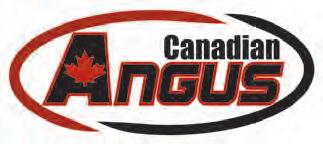
• Mail to 292140 Wagon Wheel Blvd, Rocky View County, AB T4A 0E2
• Please include the animal’s complete tattoo, your name, contact information, and member ID
• We are not able to accept requests to complete work over the phone but are happy to answer your questions
What methods of payment can I use?
• Visa or Mastercard
• E-transfer to ayuen@cdnangus.ca. Please include your member ID in the notes/memo field
• Personal or business cheque
Record the first day of natural service exposure, the AI date, or the implant date for ET calves.
What is the difference between disposal codes 12 and 15?
• Code 12 – Open, missed calving opportunity will move the animal to the next year, e.g. from Spring 2021 to Spring 2022
• Code 15 – Moved to next calving season will move the animal to the next season, e.g. from Spring 2021 to Fall 2021

We no longer require the certificates to be returned! We offer four options for your convenience:
• Email a spreadsheet with the animal tattoo or registration number, breeding information (if relevant), buyer name, address and phone number and date of sale along with consent from a signing authority.
• Fill out the transfer on the back of the certificate and fax, email or mail it to us.
• Complete the transfer form on our website and submit it electronically.
• Complete your transfers instantly on AngusNOW (please note Non-Financial transfers can not be completed on AngusNOW)
Member-to-member transfer
CAPP Member
• <30 days: $10/animal
• 30–90 days: $16/animal
• >90 days: $100/animal
Non-CAPP
• <30 days: $14/animal
• 30–90 days: $20/animal
• >90 days: $100/animal
Transfers to commercial producers
CAPP Member
• < 90 days: $16/animal
• > 90 days: $32/animal
Non-CAPP
• <90 days: $20/animal
• >90 days: $40/animal


• extract calving information any time
• simple, clean, easy-to-use interface with the same felds as the paper calving book
• free to CAA members through the app store
• create individual calf records or work from preloaded female inventory
• entire farm team and/or family members can all access and update calving information




on 283 days
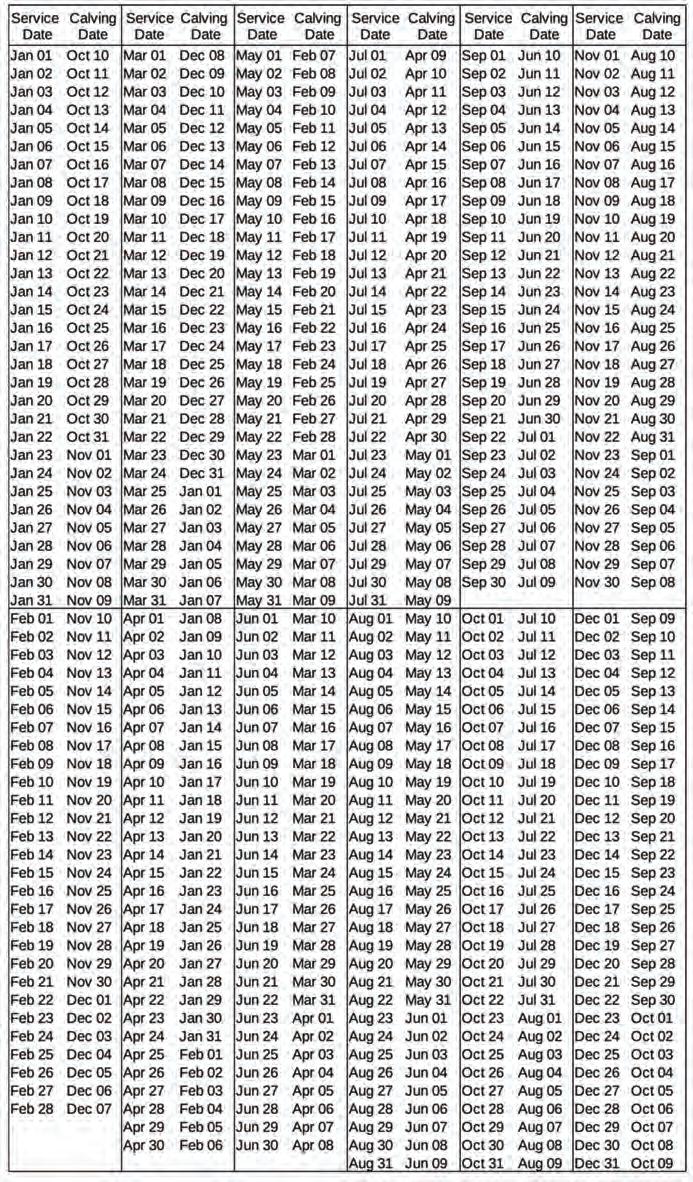


Angus-branded beef programs across Canada need and want to verify that what they are selling as Angus beef is indeed Angus. One way to prove that is by procuring cattle that are tagged with Canadian Angus Green Tags.

Tagging your animals with Canadian Angus tags has its benefits:
• Sell direct or through one of the 169 Canadian Angus Feeder Sales across Canada.
• Canadian Angus green RFID tags visually and electronically identify Angus and Angus cross cattle. It’s our guarantee that the animal bearing the tag has a minimum of 50% Angus genetics.

• CCIA compliant indicator—no other RFID indicator is required for national identification.
• There are a number of branded beef programs in Canada that are unable to find enough verified Angus cattle to satisfy their program demands. The only way to verify? With our Canadian Angus tag!
As more and more global markets demand the Angus brand, sourcing cattle to meet our brand specifications becomes of increasing importance and value. The assurance that the Canadian Angus Green Tag provides knowing purchased cattle will qualify for our Angus brands takes the guesswork out of the equation and adds value into the cattle we acquire.
Nicolas Ednie Bouvry Exports Canada• Many Angus branded programs require Angus verification for qualification into their programs. Maximize your marketing opportunities by using Canadian Angus tags. Ordering your Canadian Angus Green Tags (RFID indicators) has never been so easy:
Please order directly from CCIA online at www.canadaid.ca or call 1-877-909-2333
CCIA carries both the Datamars brand Temple Tag ComfortEar Canadian Angus RFID indicator as well as the Allflex brand Canadian Angus RFID indicator.

Weren’t able to tag your calves green? The Canadian Angus Asssociation can verify calves for your branded program through the Genuine Angus Verified program. Contact CAA for more details.




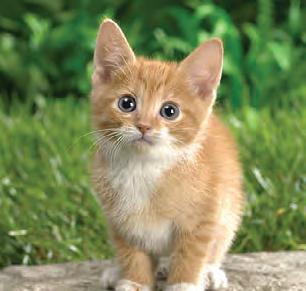



Submit test request to CAA office. Send CAA-generated paperwork and hair card to Neogen Canada.
Submit test request to CAA office. Send CAA-generated paperwork and hair card to Neogen Canada.
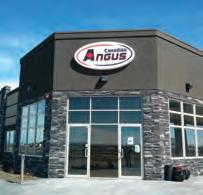

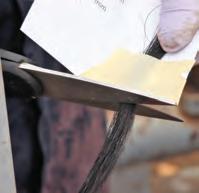











Pull hair sample from the switch of the tail. Include 50–60 hairs ensuring that the hair root bulbs are attached.
Pull hair sample from the switch of the tail. Include 50–60 hairs ensuring that the hair root bulbs are attached.


1
6

Label the hair card clearly, carefully, and accurately. Store hair card in a safe dry place until you send it to the lab.
2 3 4 5
1 2 3 4 5 6
Place hair roots on the hair card (there is a circle in the middle of the hair card that says “Place hair roots here”).
Place hair roots on the hair card (there is a circle in the middle of the hair card that says “Place hair roots here”).








Affix hair with tape at the bottom of the card (there is a rectangle that says “Place tape here”).
Trim off excess hair extending from the hair card.
Affix hair with tape at the bottom of the card (there is a rectangle that says “Place tape here”).
Canada
Roper Road NW

To register Angus cattle in Canada, you must apply for and secure the right to use a set of unique tattoo letters. Tattoo letters need only be applied for once and stay with the member as long as (s)he is an active member of the Association. If tattoo letters have not been used for seven years they may be reassigned.

Herd names are required and are used as a pre x when naming registered cattle to identify the owner at birth. Your herd name does not have to be the same as your membership name and can be shared among family members with permission.
e Canadian Angus Association by-laws state that the tattoo must be in the right ear. When you purchase animals, check the right ear tattoo and make sure it matches the registration certi cate. Contact us immediately if the ear tattoo and registration certi cate do not match.
e letters I, O, Q, and V may not be used as a year letter. After Z, the next year’s letter shall revert back to A.
Proper identi cation at birth is essential to maintain accurate herd records. e Association requires every animal to be permanently identi ed in order to be eligible for registration.
Canadian Angus animals have two rows of tattoos in the right ear. e top row will have the breeder’s registered tattoo letters, and the bottom row will contain a 1, 2, 3 or 4-digit number followed by the year letter that corresponds to the year that animal was born.

e BC Junior Angus Association (BCJAA) is a regional division of the Canadian Junior Angus Association (CJA). Both Associations consist of a Board of Directors, all of which are under the age of 21.
By purchasing their Canadian Junior Angus membership, youth that reside in BC automatically become members of the BC Junior Angus Association. Junior Angus members have opportunities to participate in both provincial and national events that o er chances for networking, learning, growth, and of course, lots of fun!
e Canadian Junior Angus Association provides two national events each year, the Guiding Outstanding Angus Leaders (GOAL) Conference and Showdown. rough interactive activities, friendly competitions, tours, and speakers, these events foster and encourage Junior’s continued learning and industry involvement.
Junior Angus members also have the privilege of applying for educational scholarships, travel bursaries, and awards that are all graciously provided by the Canadian Angus Foundation and their donors.
e Canadian Junior Angus Association and British Columbia Junior Angus Associations are both organizations striving to educate the next generation of cattle enthusiasts while creating a welcoming environment for youth to grow within!
“ e best part of being a Junior Angus member is by far the people you meet and the things you learn along the way.”
-Riley Bapty, CJA British Columbia Director 2023/24
“ e Canadian and BC Junior Angus programs have truly shaped me into the person I am today. At my rst CJA event in 2018 I was a shy girl who had no connections within and little knowledge of the Angus industry. Now, I can con dently say that I have amazing industry connections across the continent, have learned so much about the cattle industry, and have become a leader capable of positively in uencing the next generation of Junior Angus members.”
-Sarah MacDonald, CJA British Columbia Director 2019-2023
BCJAA Mission Statement - e BC Junior Angus Association will strive to present innovative opportunities to promote and educate future cattle persons dedicated to the Angus breed.
2023 – Hanna Fitchett and Jordan Bapty
2022 – Lexi Augustine
2021 – Riley Bapty
2020 – Sarah MacDonald
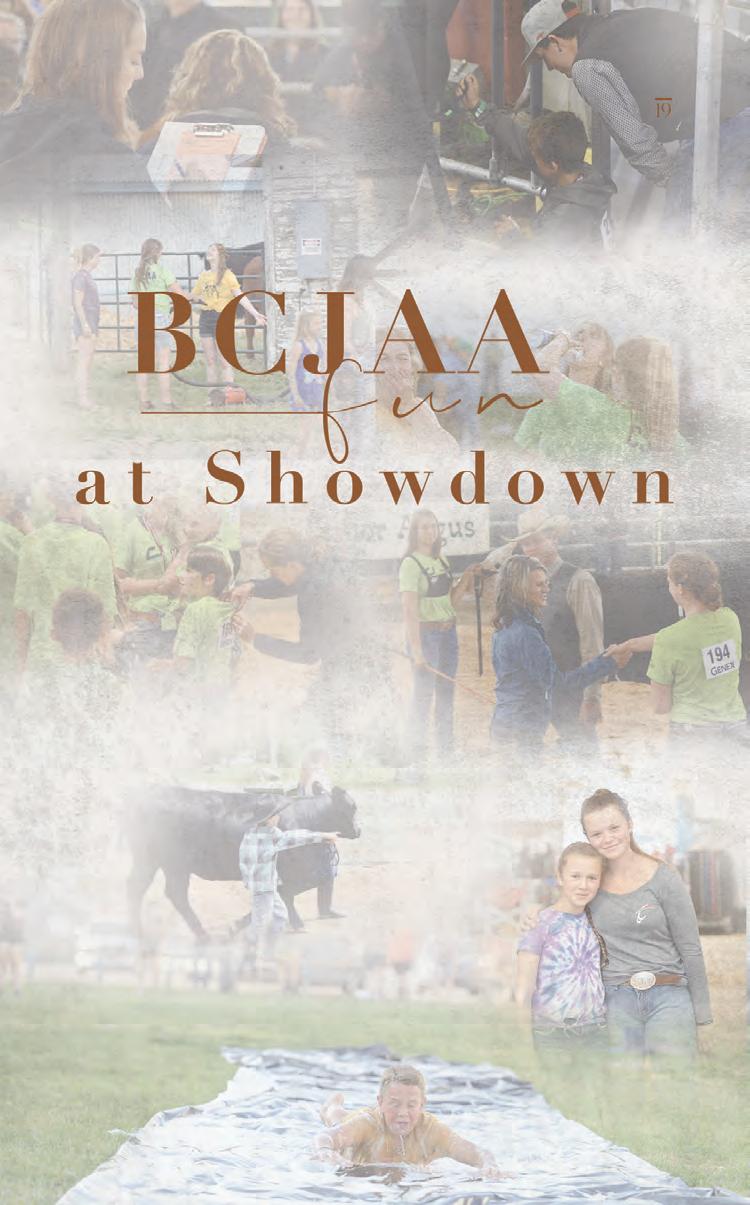
(Programs available for all BC Producers)
FEEDER ASSOCIATIONS LOAN GUARANTEE PROGRAM
BRED HEIFER ASSOCIATION LOAN GUARANTEE PROGRAM

APP INTEREST RELIEF PROGRAM
ADVANCE PAYMENTS PROGRAM
Advantages to the Producer
Feeder & Bred Heifer Associations
A reliable source of credit is available on short notice from the Associations;
The interest rate is competitive or better than on an individual basis;
5 percent deposit on feeders and 10 percent deposit on bred heifers;
The association is controlled by the members;
Livestock mortality insurance
APP Interest Relief
Interest free provision on feeder contracts up to $350,000.00
Interest Free rate per head is 50% of expected market value as determined by AAFC
Advance Payments Program
Cash Advance on cattle, sheep, bison, forage and grain up to $1,000,000.00 with the first $350,000.00 being interest free.
Interest bearing portion of cash advance is at prime plus .25%
Advance rate is 50% of the expected market value/head as determined by AAFC
Producers must be enrolled in Agri-Stability or WLPIP (Livestock Advance) and/or Production Insurance for Grain or Forage Advance
Production Periods are 24 months (Livestock) and 18 months (Forage/Grain) starting April 1st of each year
Cattlemen please contact your local association:
Central Interior Feeders Cooperative Association
Secretary: Audrey Cooper, Vanderhoof Phone: 250/567-2049 Fax: 250/567-9049
Email: audreycifca@gmail.com
North Peace B.C. Feeder Co-Operative
South Peace Bred Heifer Co-Operative
North Peace B.C. Bred Heifer Co-Operative
Secretary: Connie Patterson, Dawson Creek Phone: 250/782-6272 or 250/219-0791 Fax: 250/782-1881
Email: pcc@neonet.bc.ca
Cariboo Bred Heifer Cooperative
Cariboo Chilcotin Cooperative Feeders Association
Fraser Nechako Bred Heifer Cooperative Association
Secretary: Lindy Gilson, Quesnel Phone: 250/992-8483 Fax: 250/992-8489
Email: bearvlly@telus.net
Or For More Information contact: www.bcbfa.ca
BCBFA BC Breeder & Feeder Association
395 Kinchant Street Quesnel BC V2J 2R5
Lindy Gilson Phone: 250/992-8483 Fax: 250/992-8489
Email: bearvlly@telus.net

Reprinted from the 2023 Canadian Compendium of Veterinary Products

Reprinted from the 2023 Canadian Compendium of Veterinary Products

Reprinted from the 2023 Canadian Compendium of Veterinary Products
The following charts list those available for use in Canada as of August 2023. Please use this information to help develop a herd health program which fts your needs. Consult with your veterinarian to fnd the product most benefcial for your herd. Remember that these vaccines all have a withdrawal period before the animal may be slaughtered for human consumption and many should not be given to pregnant cattle. PLEASE READ THE LABEL!

Vaccines work best if given 2 weeks prior to the stress of trucking, weaning or even calving in the case of scour vaccines given to mother cows. PLEASE READ THE LABEL!
Vaccines help prevent diseases when used correctly. Proper lasting immunization often requires a booster. Many vaccines are live biologicals and must be stored and handled as directed by the manufacturer in order to be effective. PLEASE READ THE LABEL!


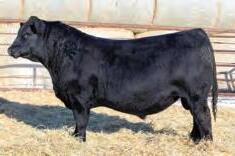







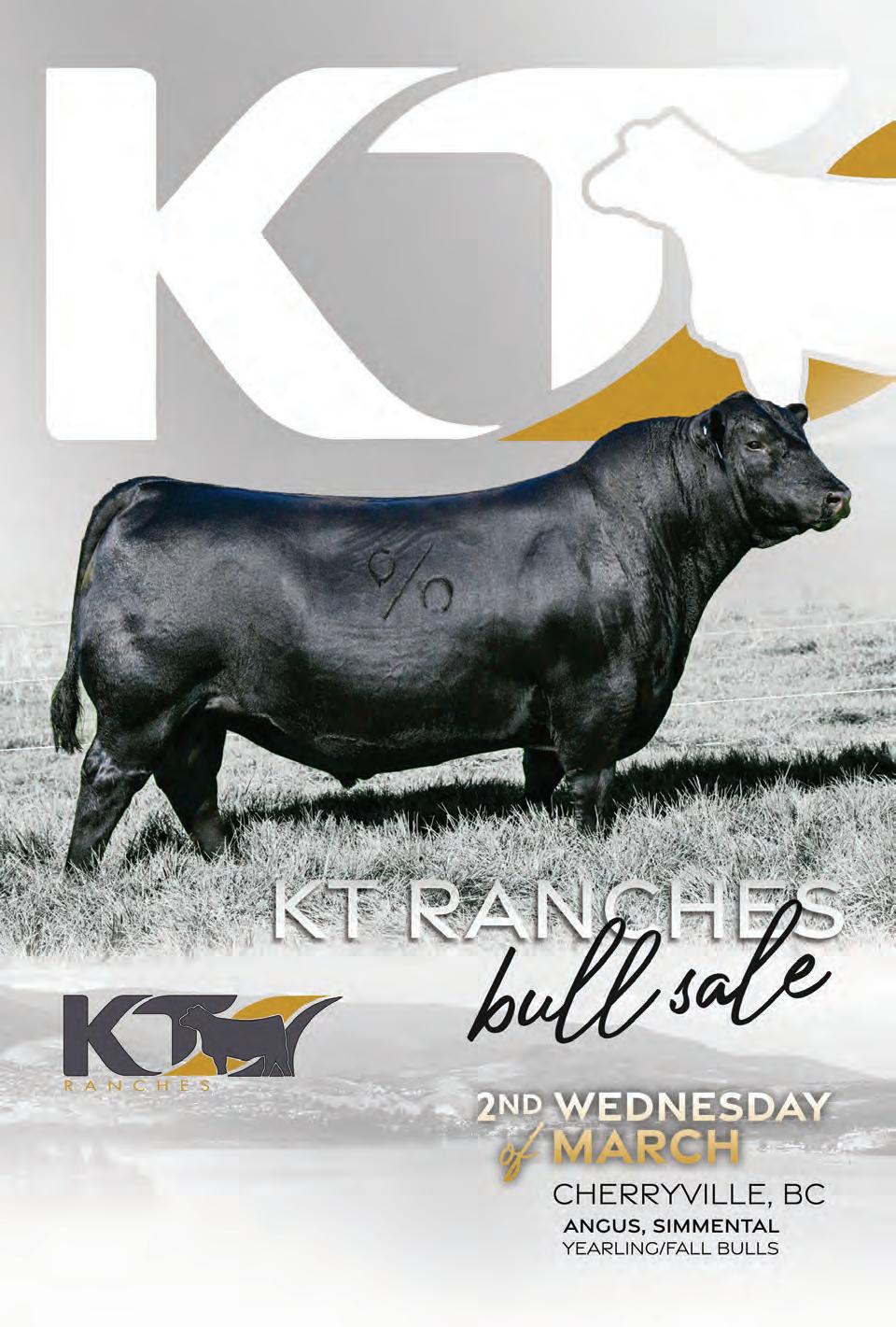
Analgesics (Pain Control)
Anafen® Injection 100 mg/mL
Banamine® Sterile Injectable Solution
Lidocaine HCl 2% & Epinepherine Injection USP
Meloxicam Oral Suspension, USP
Metacam® 20 mg/mL or 40 mg/mL Solution for Injection
Antibiotics / Antimicrobials
Baytril 100
Bio-Mycin® 200
CalfSpan Tablets
Depocillin®
Draxxin® Injectable Solution
Excenel® RTU EZ Sterile Suspension
Liquamycin LA-200
Micotil TM
Nu or®
Oxyvet® 200 LA
Res or®
Antiparasitic (Dewormers)
Baycox (toltrazuril) 5% oral Suspension
Bimectin® Injection or Pour-On
Boss® Pour-On
CyLence TM Pour-On Insecticide
Dectomax® Injectable Solution
Eprinex® Pour-On
Invermectin Pour-On for Cattle
LongRange®
Valbazen®
(Selenium)
Sterile Solution

Reprinted from the 2023 Canadian Compendium of Veterinary Products









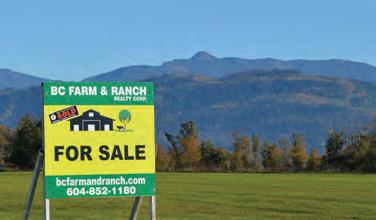
EPDs are calculated using pedigree, performance and genomic data. Canadian Angus members participate in the voluntary Performance Program through which they collect and submit performance data on fertility, calving ease, growth, structure, carcass quality, and feed e ciency for their calves. A big thank you to all our members who take the time to measure and record this data; without you we cannot generate the genetic selection tools that we do. Many members have started measuring and submitting phenotypes for the new traits introduced here. As you start calving, please do not forget to record teat and udder scores on your cows.
EPDs are a genetic selection tool that some producers appreciate and use to select their bulls.

Production EPDs:
Calving Ease Direct (CED) EPD describes the percentage of expected unassisted births when a bull is exposed to rst-time heifers. e higher the number, the higher the probability that rst-time heifers bred to the bull in question will calve with no assistance. e EPD predicts the average di erence in ease with which a sire’s calves will be born when he is bred to rst-calf heifers.
Birth Weight EPD (BW) EPD describes in pounds the di erence in expected progeny weight, on average. A bull with a BW EPD of +4 will, on average, sire calves that are 2 pounds heavier than a bull with a BW EPD of +2 (given equal management).
Weaning Weight EPD (WW) EPD describes in pounds the di erence in expected weaning weight in progeny, on average. WW EPD is a predictor of a sire’s ability to transmit weaning growth to his progeny compared to that of other sires. A bull with a WW EPD of +50 will sire calves that are, on average, 20 pounds heavier at weaning than a sire with a WW EPD of +30 (given equal management).
Yearling Weight EPD (YW) EPD describes in pounds the di erence in expected yearling weight in progeny, on average. YW EPD is a predictor of a sire’s ability to transmit post weaning growth to his progeny compared to that of other sires. A bull with a YW EPD of +100 will sire calves that are, on average, 30 pounds heavier at weaning than a sire with a WW EPD of +70 (given equal management).

Residual Average Daily Gain (RADG) EPD describes an animal’s ability to grow post weaning on a constant amount of feed. RADG EPD, expressed in pounds per day, is a predictor of a sire’s genetic ability for postweaning gain in future progeny compared to that of other sires, given a constant amount of feed consumed. A bull with an RADG EPD of +1.5 will sire calves that, on average, will grow 1 extra pound per day more than calves from another bull with an RADG EPD of 0.5—on the same amount of feed.
Dry Matter Intake (DMI) EPD describes the feed intake potential for weaned calves from one sire compared to the feed intake potential of calves from another sire. is EPD is expressed in pounds per day. Weaned calves from Sire A with a DMI EPD of 0.50 will eat approximately 0.5 pounds of dry matter a day more than weaned calves from Sire B with a DMI EPD of 0.00. is EPD should also be used in conjunction with a growth EPD, such as YW EPD, as unlike RADG EPD, it does not include a growth component. Used independently of a growth EPD the DMI EPD selects solely for appetite.
Scrotal Circumference EPD (SC) EPD describes the di erence in average scrotal circumference in sons. Expressed in centimetres, a sire with an SC EPD of 1.2 will, on average, have sons with scrotal circumference that is 1 centimetre larger than the sons from a sire with an SC EPD of 0.2. SC EPD has also been correlated with daughter’s age at puberty and progeny fertility.
Docility (Doc) EPD is expressed as a di erence in yearling cattle temperament, with a higher value indicating more favourable docility. It predicts the average di erence of progeny from a sire in comparison with another sire’s calves. In herds where temperament problems are not an issue, this expected di erence would not be realized.
Claw Set (Claw) EPD is expressed in units of claw-set score, with a lower EPD being more favourable indicating a sire will produce progeny with more functional claw set. Ideally, toes are symmetrical, even and appropriately spaced.
Foot Angle (Angle) EPD is expressed in units of foot-angle score, with a lower EPD being more favourable indicating a sire will produce progeny with more ideal foot angle. e ideal is a 45-degree angle at the pastern joint with appropriate toe length and heel depth.
Carcass EPDs:
Carcass Weight (CW) EPD is expressed in pounds and is a predictor of the di erences in hot carcass weight of a sire’s progeny compared to progeny of other sires. A bull with a CW EPD of +30 will sire calves that, on average, will result in 10 pounds more hot carcass weight than the progeny of a bull with CW EPD of +20.
Marbling (Marb) EPD describes the marbling potential of calves from one bull compared to the calves from another bull, given the same management. is EPD is expressed as the di erence in grade score. Given the same management, the calves from a bull with a Marb EPD of 0.6 will marble ½ a grade score better than the calves from a bull with a Marb EPD of 0.1.
Ribeye Area (RE) EPD describes in square inches the di erence in ribeye area of a sire’s progeny compared to progeny of other sires. Fat ickness (Fat) EPD expressed in inches, describes the di erences in back fat thickness at the 12th rib (as measured between the 12th and 13th ribs) of a sire’s progeny compared to progeny of other sires.
Maternal EPDs:
Heifer Pregnancy (HPG) EPD is a selection tool to increase the probability or chance of a sire’s daughters becoming pregnant as rst-calf heifers at rst exposure. A higher EPD indicates a higher probability of conception.
Calving Ease Maternal (CEM) EPD describes the probability of not requiring assistance when a bull’s daughters calve for the rst time. e higher the EPD, the higher the probability that a bull’s daughters will not require assistance at calving time.
Milk EPD describes, in pounds, the portion of a calf’s weaning weight attributed to milk and mothering ability. On average, daughters from a bull with a Milk EPD of +20 will contribute 5 pounds more to their calves’ weaning weight than the daughters of a bull with Milk EPD of +15. Milk EPD is a threshold trait that should be maintained at a moderate level dependent on the management and environment of the herd.
Mature Weight (MW) EPD expressed in pounds, is a predictor of the di erence in mature weight of daughters of a sire compared to the daughters of other sires.
Mature Height (MH) EPD expressed in inches, MH EPD is a predictor of the di erence in mature height of a sire’s daughters compared to daughters of other sires.
With the Canadian Angus Association
Expected progeny differences (EPDs) are genetic selection tools that provide producers a measure of an animal’s genetic merit for traits that are economically relevant to their operation. Basically, EPDs are a measure of how an animal’s progeny can be expected to perform, on average.
An animal’s genetics will contribute in part to how it performs. A portion of that performance is also dictated by the environment provided to that animal. The environment includes weather, disease, feed, stress, handling, vaccination protocols, maternal environment, housing, and the animal group dynamics. The environment differs for each herd as geography and producer management
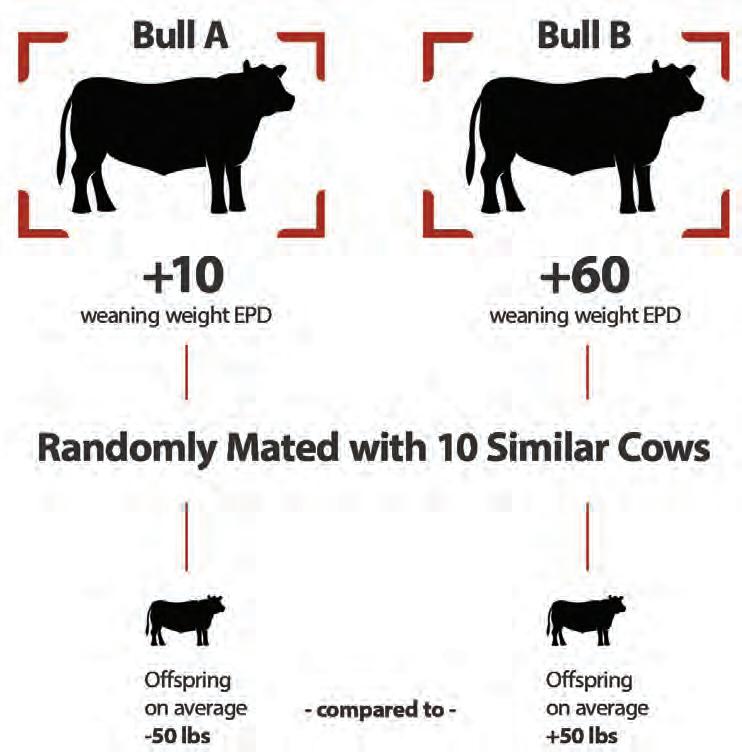
plays a large role in environment. EPDs remove the environment from all traits measured and provide producers with an estimate of the genetics that contribute towards each trait.
For more information on EPDs, visit: www.cdnangus.ca/addingvalue/angusone-epd-geneticevaluations/

EPDs: are a universal way of describing the genetic potential of progeny from breeding stock
EPDs: are a genetic selection tool that can help producers reach a breeding selection goal for their herd
EPDs: can help you maintain the traits that you want to keep in your herd
EPDs: can help you avoid traits that you might not wish to use on your cow herd and introduce into your herd
EPDs: are a great way to describe the high quality Canadian Angus genetics that you raise to your customers
EPDs: are the only fair way to compare breeding stock across herds and diferent environments





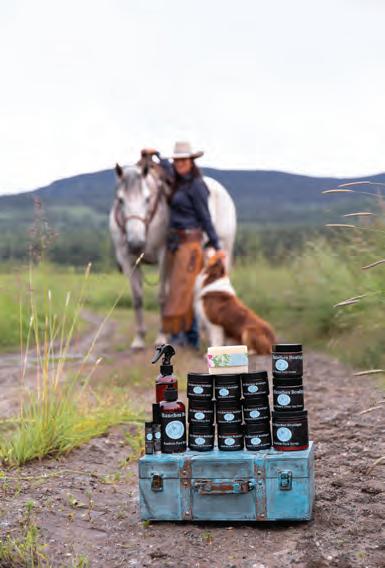

Did you share a bull or sell semen from a bull?
• A sire authorization form must be submitted to allow members without ownership access to the bull. As of January 1, 2021, there is a $50 fee per sire authorization (linked herds are included in same fee). If a member prefers, they can set the bull up for public access for a one-time $100 fee. The AI approval fee for imported bulls is $400.
Tips for Importing animals, semen or embryos.
NOTE: All imported genetics need to meet CAA registration requirements.
• Submit the import request on the CAA application for import form with the $75 animal import fee
• Provide proof of ownership and proof of legal import from CFIA
• CAA will contact the association of origin for parentage verification information (a $15 fee may apply). You may need to arrange for a DNA sample for the animal or its parents to be submitted if information is incomplete or unavailable.
All sires born on or a er January 1, 2019 must have DNA on file with CAA showing parentage verification (to both sire and dam) before their offspring can be registered.
How do I submit DNA samples?
• Hair, blood, tissue, and semen are all accepted
• All samples must be clearly labelled with complete tattoo information to avoid processing delays and extra charges
• Hair cards are provided to members at no cost, courtesy of CAA. Samples must be fixed to these bar-coded cards or each loose hair sample will be assessed a lab processing fee of $4.
• DNA samples that are not labelled or that are submitted to the lab without a DNA test request are subject to a fee of $54. These samples impact the lab turnaround times for all samples.
• Blood cards and tissue sampling units (TSUs) can be ordered from CAA
How long does it take to get my DNA results?
• Our lab, Neogen Canada, aims to report all DNA test results, including genetic condition testing, parentage verification testing, Angus GS testing, and coat colour tests, within 21 calendar days of the sample arriving at the lab
• GEPDs and Genomic Percentile Ranks from Angus GS tests require an additional 2–6 weeks to be incorporated into our monthly genetic evaluations a er the tests are complete
• To verify that your DNA sample arrived at the lab and find your estimated date for results, check the DNA Portal on our website at www.cdnangus.ca/dna-portal
Effective June 1, 2022, the below tests will increase their fees. All other tests will remain unchanged
Parent Verification will now be $20/animal (previously $18). This affects these tests:
• Parent Verification (PV)
• Parent Verification (PV) Retest
• Parent Verification (PV) Spot Test
Genetic Condition Testing will now be $23/ animal (previously $22). This affects these tests:
• AM
• CA
• DD
• DM
• DW
• MA
• NH
• OH
• OS
• To order Canadian Angus RFID tags, call CCIA at 1-877-909-2333 or order online at www.tags. canadaid.ca. As of May 31, 2019, Angus RFID tags are sold through CCIA and are no longer available direct from CAA.

• Allflex management tags can be purchased through CAA
• Leader Products management tags can be ordered from www.leaderproducts.com or by calling 1-833-549-1563

For best results perform AI 12 ± 2 hr after detection of estrus. Use of estrus detection aids (EDA) is highly recommended.

Select Synch & TAI
Heat detect & AI days 6 to 10 and TAI with GnRH all non-responders 72 - 84 hr after PG.
PG 6-day CIDR® & TAI
Heat detect & AI days 0 to 3. Insert CIDR to non-responders, heat detect & AI days 9 to 12. TAI with GnRH non-responders 72 - 84 hr after CIDR removal. Protocol may be used in heifers.
Select Synch+CIDR® & TAI
Heat detect & AI days 7 to 10 and TAI with GnRH all non-responders 72 - 84 hr after PG.

Time for Fixed-time AI (TAI) should be considered as the approximate average time of insemination based on the number of females to inseminate, labor, and facilities.
Aervoe™, AIPAint™, Detect-her™ Estrotect™ Kamar™, Mark-her™, Paintstik™, Quick Shot™ Tell Tail™, Twist-Stik™
Cystorelin®, Factrel®, Fertagyl®, OvaCyst® GONABreed® estroPLAN®, Estrumate®, Lutalyse®, Lutalyse® HighCon, ProstaMate® SYNCHSURE™
These protocol sheets were assembled by the Beef Reproduction Task Force. Programs are intended to promote sustainable food production systems by the beef industry through sound reproductive management practices for replacement heifers and postpartum cows. The Beef Reproduction Task Force recommends working with a licensed veterinarian for proper use and application of all reproductive hormones. Approved 11-17-2022. www.beefrepro.org
For additional synchronization protocols visit BeefRepro.org
For best results perform AI 12 ± 2 hr after detection of estrus. Use of estrus detection aids (EDA) is highly recommended.

Time for Fixed-time AI (TAI) should be considered as the approximate average time of insemination based on the number of females to inseminate, labor, and facilities.
Aervoe™, AIPAint™, Detect-her™, Estrotect™, Kamar™, Mark-her™ Paintstik™, Quick Shot™ Tell Tail™, Twist-Stik™
EDA GnRH PG
Cystorelin® Factrel® Fertagyl® OvaCyst® GONABreed® estroPLAN® Estrumate® Lutalyse® Lutalyse® HighCon, ProstaMate®, SYNCHSURE™
These protocol sheets were assembled by the Beef Reproduction Task Force. Programs are intended to promote sustainable food production systems by the beef industry through sound reproductive management practices for replacement heifers and postpartum cows. The Beef Reproduction Task Force recommends working with a licensed veterinarian for proper use and application of all reproductive hormones. Approved 11-17-2022. www.beefrepro.org

the Cow-Calf Herd


2.
3.
It’s pretty easy to blame the bull for lower than expected pregnancy rates or weaning weights, but sometimes the fault may lie with the cows. Cows’ fat cover (condition) plays an enormous role in reproductive e ciency, calf immunity, calf health, and even calf growth rate.
Ideally, a cow should maintain a calving interval of 365 days. This means she has 80-85 days, at best, to cycle and rebreed after calving. Every missed cycle can result in as much as 42 lbs of calf weaning weight lost, not to mention dragging out the calving season and decreasing the uniformity of your calf crop.
Cows’ available energy is first used for general maintenance, then growth, and finally reproduction. In under-conditioned cows, cycling and rebreeding are the first things to go. Over-conditioned cows usually don’t have a problem getting bred, but excess fat tends to accumulate in the udder and birth canal, causing reduced milk production and increased incidence of calving problems. Feeding cows to excess condition is also economically impractical.
Post partum interval (PPI) is the length of time from calving to the first heat after calving. Research from Purdue University demonstrated that PPI increased substantially with a lower body condition score (BCS) at calving. Cows with a BCS of 3 at calving had an average PPI of just over 59 days, while it took those with a BCS of 2 more than 88 days to come back into heat –meaning a calving interval longer than one year in those thinner cows. It is also important that cows do not lose condition after calving prior to breeding. Cows that decline in condition after calving have a PPI 20-30 days longer than cows that maintain condition until breeding.
Similar results are seen when comparing pregnancy rates. Oklahoma State researchers compared pregnancy rates for di erent BCS in beef cows. At a BCS of 2, only 50% of the cows became pregnant over the 90 day breeding season, while 81% of cows at a BCS 3 became pregnant during the same time period.
BCS also a ects calf immunity, with thinner cows producing less colostrum that contains lower levels of immunoglobulins. The results from a large field trial (601 calves) in Saskatchewan showed calf immunoglobulin G (IgG) levels as much as 19% higher from calves born to cows with a BCS of 3 or greater. This same research demonstrated that the odds of both calf treatment and death increased when IgG levels in the blood fell below 24 g/L.

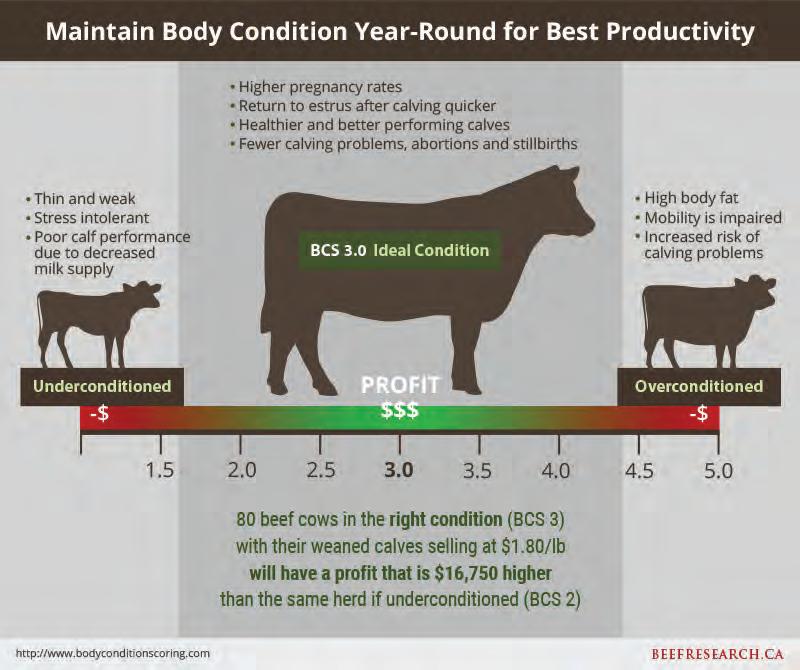
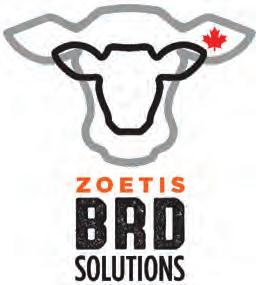
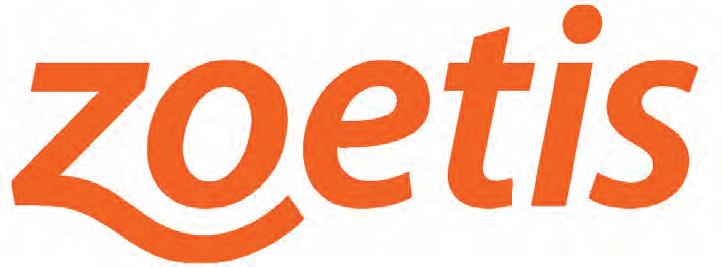


University studies in Wyoming and data from Montana and Colorado lend credence to the following conclusions:
1. e birth weight itself in uences calving ease by 65%
2. e female has 60-70% in uence on birth weight of her calf
3. e bull has 30-40% in uence on birth weight of his progeny
4. Pelvic measurement and angle, as well as the shape of the calf have 35-40% in uence on calving ease
5. Length of gestation greatly a ects birth weight. A fetus can gain over one pound per day in the last days of gestation
6. Weather and temperature the last 30 days a ect the length of gestation
7. Size and maturity of the cow in uence calving ease
If you are not physically recording birth weights, guessing is as accurate as driving with a broken speedometer—what’s thought to be 55 MPH may in fact be 65 of 70 MPH, and what’s thought to be 70-80 lbs may actually be 80-90 lbs. Remember, everything is relative. Increased growth, frame and performance will increase BW. A longer bodied calf will weigh more. If a calf is expected to have genetics for growth, it will display this prior to birth as well as after. As a rule of thumb, it takes a calf weighing 86 lbs at birth to nish at 1200-1250 lbs. A cow should easily give birth to a calf weighing 8% of her own body weight. us a 1200 lbs cow should give birth to a 96 lbs calf with ease.
Continued selection for low birth weight will ultimately reduce the mature sizes and performance of your cattle.


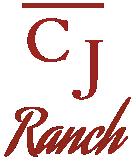




BC large animal producers now have access to two mobile livestock emergency response trailers that are equipped with supplies needed if an accident while transporting livestock occurs. Each trailer is available during critical times to ensure producers have access to the necessary tools and equipment to take care of their animals and keep them safe.
Each trailer is equipped with rescue supplies – such as horse and cow halters, corral panels, tools, rst aid kits, safety clothing and a re extinguisher, etc.

If a stock trailer or cattle liner accident occurs along a road or highway, the emergency trailer may be deployed, if within reasonable distance of the accident.
e two Emergency Livestock Response Trailers located in Ja ray, BC to cover the East Kootenays and Williams Lake to cover the Cariboo Area.

FOR EMERGENCY DEPLOYMENT CALL: 1-877-314-9686

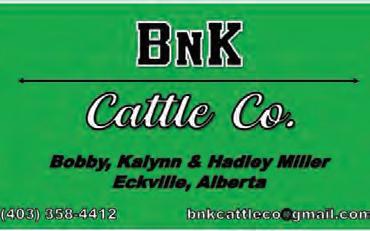

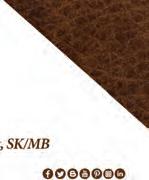

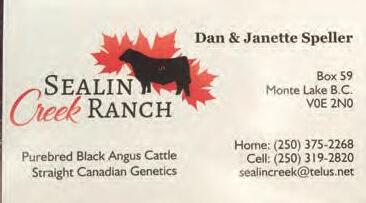



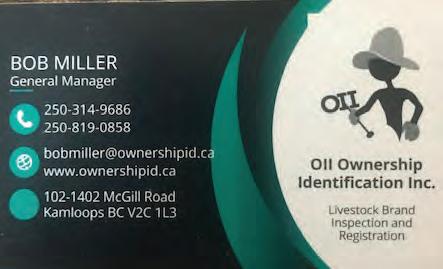



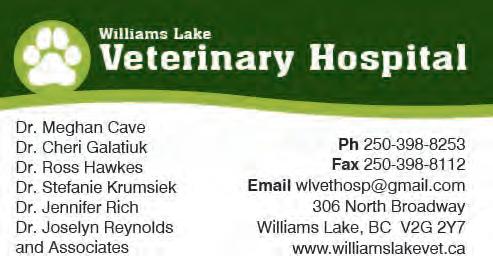




Angus & Angus Influence Feeder Calf and Yearling Sales are hosted annually at BC Livestock Producers Cooperative facilities located in Okanagan Falls, Kamloops, Williams Lake and Vanderhoof.

These sales are traditionally held in October and early November. BC Angus Association representatives attend these events.
As of 2023, Angus feeder sales have been in existence for twenty-two years across Canada.

Nominations for the Commercial Breeder of the Year are accepted from the membership each year and are decided on by the board.
e successful recipient is presented with an award at the Annual General Meeting or a mutually agreed upon event as well as announced on our social media channels and website.
Previous BC Angus Commercial Breeder of the Year Recipients

2023 – Woodjam Ranch, Chad & Ricky Seelhof & family, Horse y, BC
2022 – Nicola Ranch, Merritt, BC
2021 – Allison Creek Ranch, Linda Allison & son Shelby, Princeton, BC
2020 – River Ranch, Ken & Deb Ilnicki, Williams Lake, BC
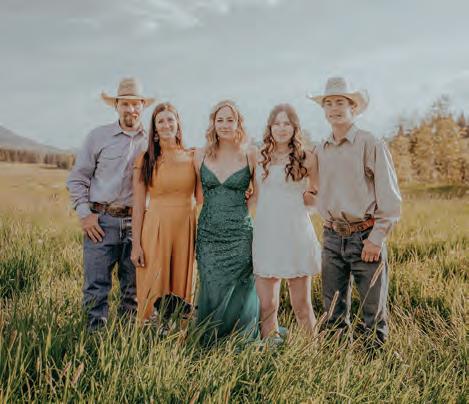
Jennifer Albertson, Windy Meadow Ranch, Vanderhoof, BC 250-877-0786
John Appleby, Eastview Farms, Coldstream, BC 250-542-1979
Alexa Augustine, Horse y, BC 250-620-3309
Joey Augustine, Horse y, BC 250-620-3309
Steven & Christine Aylward, Gumbo Gulch Cattle Co., Pouce Coupe, BC 250-784-5136
Ken Ayre, Still Meadows Angus, Langley, BC 604-533-8316
John & Cathy Bakker, Pool Bakker Angus, Bridesville, BC 604-308-2206
Riley Bapty, Coldstream, BC 778-212-4900
Kim Beaudette, Burns Lake, BC 250-698-7467
Anne & Phil Bell, High Country Acres, Charlie Lake, BC 250-785-8505
Curtis & Tracey Bellows, Bull Pine Farms, Salmon Arm, BC 250-833-8011
Ella Belsham, Houston, BC 778-266-0076
Tanya Belsham, Poplar Meadow Angus, Houston, BC 250-845-8474
Taylor & Alaina Belsham, Houston, BC 250-845-3050
Bobbi-Jo & Tim Best, Best Cattle Co., Progress, BC 250-267-2592
Brad Dearden &Tanya Brouwers, Darke Creek Ranch, Summerland, BC 250-494-7277
Cody & Miranda Brown, Bar Diamond Ranch, Chetwynd, BC 250-401-8048
Sydney Brown, Merville, BC 250-337-1834
Robyn Burt, Dragon View Angus, Quesnel, BC 250-991-2993
Ruger Campbell, Vanderhoof, BC 250-567-0358
Bud, Donna & Shawn Carter, Keremeos, BC 250-499-2387
Taylor ompson & Jodi Carter, Keremeos, BC 250-499-2387
Brad & Aleta Chappell, Heart of the Valley Farms, Courtenay, BC 250-337-8097
Charles Ranch, Cache Creek, BC 250-457-3106
Chilancoh Ranch Ltd., Redstone, BC 250-394-4404
C-Jay Ranch, Houston, BC 250-845-3330
Columbia Lake Ranch Ltd, Canal Flats, BC 250-581-1703
Tyrel Ho man & Joanne Cook, Cook Angus, Williams Lake, BC 250-398-2805
Lincoln & Alicia Copeland, Biltrite Red Angus, Montney, BC 250-262-7629\
Samuel & Ann Daley-Latreille, Daley-Latreille Ranch, Quesnel, BC 250-992-7910
Jay Dancey, Smithers, BC 250-847-3485
Myles Dekker, Houston, BC 250-845-4002
Riley Derose, Williams Lake, BC 250-392-5747
Tom DeWaal, Harvest Angus, Prince George, BC 250-562-5200
Abigail Dickson, C-Jay Ranch, Topley, BC 250-696-3646
Maggie Dickson, C-Jay Ranch, Topley, BC 250-696-3646
Tom & Amber Ditner, Broken Stick Ranch Ltd., Baldonnel, BC 250-794-7105
Diane Fletcher & Charles Dwinnell, Mountain Ash Angus, Quesnel, BC 250-249-5203
Peter Dyck, Abbotsford, BC 604-897-2704
Daniel & Georgia Dykstra, DG Cattle Co., Vanderhoof, BC 250-567-0780
Rylonn Elliot, Bridesville, BC 250-528-0040
Savanna Elliot, Rock Creek, BC 250-446-2070
Molly urston & Greg Evans, GT Evans Holdings & Pearl Cattle Co., Creston, BC 403-934-1699
Dallas & Amanda Fitchett, Quesnel, BC 250-503-6431
Hanna Fitchett, Quesnel, BC 250-503-6431
Taylor Fitchett, Quesnel, BC 250-503-6431
Jade Fossen, Fossen Ranch, Rock Creek, BC 250-446-2203
Blaine Gerstel, Chetwynd, BC 250-401-7187
Lukas & Jelissa Golbeck, Golbeck Cattle, Cecil Lake, BC 250-718-6271
Robbie & Lucille Gra , V-2 Cattle Company, Sunset Prairie, BC 250-780-2074
Byrch Grant, Grant Farms, Pouce Coupe, BC 250-782-0123
Jackie & Ron Groot, J & R Ranch, Houston, BC 250-845-4391
Rebekah Groot, Houston, BC 250-845-7616
Owen Hamilton, C-Jay Ranch, Houston, BC 250-845-4578
Seth Hamilton, C-Jay Ranch, Houston, BC 250-845-4578
Tom & Linda Hancock, Chisholm Canyon Ranch, Clinton, BC 778-786-0815
Jason & Meagan Harasimiuk, Prince George, BC 250-640-5931
Cameron Herman, Cameron Ranch, Quesnel, BC 250-255-2351
Katelyn Hesketh, Westbridge, BC 250-444-2645
Alana Higgins, Knutsford, BC 250-318-8403
Aubree Higgins, Knutsford, BC 778-257-2792
Emalee Higgins, Knutsford, BC 778-257-3137
Joe Hockley, Cherry Creek Holdings, Cranbrook, BC 250-426-9680
Brett Holland, Prince George, BC 250-560-5668
Lisa Holland, Prince George, BC 250-560-5668
Steve Hooke, Del Sol Farm, Lumby, BC 250-308-5944
Kevin & Meghan Hooper, Mystic Mountain Angus, Smithers, BC 250-643-4569
Barbara Howell, Hiwan Ranch, Kamloops, BC 250-374-5771
Bryce Hughes, Ta ka Angus, Lumby, BC 250-547-6584
Wayne & Gillian Hughes, Lumby, BC 250-547-6584
Craig Huisman, JC Ranch Ltd., Barriere, BC 604-799-6337
Katy Jasper, Riske Creek, BC 250-659-5606
Brooke Je reys, He ey Creek, BC 250-578-7897
Morgan Je reys, He ey Creek, BC 250-578-7897
Toby Je reys, Sundowner Farms, He ey Creek, BC 250-578-7837
Harley Jette, Stoneyview Farms, He ey Creek, BC 250-819-6271
Jeremiah Johnston, 150 Mile House, BC 250-267-2573
Lucia Johnston, 150 Mile House, BC 250-267-2573
Scarlett Johnston, 150 Mile House, BC 250-267-2573
Evan & Kim Keen, Keen Industries Ltd., Charlie Lake, BC 250-271-0548
Caitlyn Kelly, Charlie Lake, BC 250-783-0093
Kevin & Nickie omson, KN Farms, Vanderhoof, BC 250-567-5609
Peter & Rena King, Locash Ranch, Fort St John, BC 250-262-5408
Delano Kjos, Tomslake, BC 403-827-1819
Marty & Miriam Kjos, Baldonnel, BC 250-787-0970
Garth Klein, Shaver Angus, Rock Creek, BC 250-528-1991
Caleb Knoll, Pinantan Lake, BC 250-573-2100
G. Kokkelink, Hurst Mount Farm, Saanichton, BC 250-652-5564
KT Ranches, Kelowna, BC 250-862-6666
Stefan Langenegger, Langenegger Cattle Co. Ltd., Salmon Arm, BC 250-832-6406
Lisa Lavasseur, Terracana Ranch & Resort Ltd., Valmount, BC 250-968-4304
Roger Lepetich, Quesnel, BC 250-747-3323
Saphira Lewis, Houston, BC 250-845-8476
Jay London, J9 Ranches, Dawson Creek, BC 250-719-8819
Brent & Lia Long, Blast Angus Farm, Houston, BC 250-845-3500
Frank & Miriam Ludwig, Vanderhoof, BC 250-567-9466
Dave & Kendra Luttmerding, Armstrong, BC 250-546-0169
Jean MacAulay, Armstrong, BC 250-514-6216
Cameron MacDonald, Vanderhoof, BC 250-528-0375-
Greg & Jennifer MacDonald, Vanderhoof, BC 250-528-0375
Sarah MacDonald, Vanderhoof, BC 250-446-9317
Wade MacDonald, Vanderhoof, BC 250-528-0375
Robert & Linda Macham, Quesnel, BC 250-747-8471
Taylor Maciborsky, Horse y, BC 250-305-4688
Melissa MacIsaac, Spruce Ridge Farm, Vanderhoof, BC 250-567-9075
Kenny Mackenzie, Golden, BC 250-348-2034
Roderick or Kendyn Mackenzie, Golden, BC 250-348-2034
Doug MacLeod, Extreme Cattle Ltd, Kamloops, BC 250-372-5454
Todd Manuel, Lazy Moon Ranch, Burns Lake, BC 250-694-3294
Pam McGuinness & Todd Marchant, Big Lake Ranch, BC 250-243-2086
John & Linda Massey, Pritchard, BC 250-572-4434
Colin & Gail Matejka, Matejka Farms of BC, Enderby, BC 250-838-6080
Terry Milton & Lara Matthews, Valleyview Ranch, Malakwa, BC 250-253-0465
Judy Madden & Mike McConnell, Double M Ranching, Dawson Creek, BC 250-782-7875
Amanda McGillivray, McGillivray Land & Livestock Ltd., Kamloops, BC 250-374-9495
Matthew McGillivray, Kamloops, BC 250-371-1948
Meghan McGillivray, McGillivray Land & Livestock Ltd., Kamloops, BC 250-320-3458
Susan & Jason McGillivray, McGillivray Land & Livestock Ltd., Kamloops, BC 250-374-9495
Breanne Mckinnon, Port Alberni, BC 250-731-3936
Andy & Jan Meints, Meints Cattle Co., Houston, BC 250-845-7319
Bob Miller, Tobiano, BC 250-819-0858
Michael & Donna Mills, Ardgowan Black Angus, Aldergrove, BC 604-857-2195
Mitchell Cattle Company, Barriere, BC 250-319-8501
Jordan Moncks, Burns Lake, BC 403-894-6555
Jim & Shirley Moon, Red Moon Angus, Vanderhoof, BC 250-567-9762
Tom Moon, Red Moon Angus, Vanderhoof, BC 250-567-9762
Luke & Amanda Muehlen, LA Ranch, Vanderhoof, BC 250-567-7375
William Mulvahill, Alexis Creek, BC 778-417-0126
Robyn Mumford, Hillside Red Angus, Alexis Creek, BC 250-305-7141
Arlee Newsham, Champagne Angus Ranch, Cecil Lake, BC 250-264-2201
Brody Newsham, Champagne Angus Ranch, Cecil Lake, BC 250-264-2201
Kelly Ollenberger, Ollenberger Stock Farms, Goodlow, BC 250-262-1432
Dennis Patrick, Hope, BC 604-869-3839
George Pearson, Cadillac Ranch, Kamloops, BC 250-372-9721
Crystal Pellikaan, Salmon Arm, BC 250-517-9744
Cameron & Valerie Percy, Quesnel, BC 250-306-2179
Dennis Gracey & Debra Pion, Edgewood, BC 250-269-7655
Kyle & Jessica Price, Charcoal Creek Cattle Co., Falkland, BC 250-379-2116
Pete & June Puhallo, Puhallo Angus, Kamloops, BC 250-579-8913
Dale Regehr, Tannin Manor, Langley, BC 604-308-4555
Frank Riley, Celista, BC 250-955-2924
Colin Rissanen, CJ Farms, Abbotsford, BC 604-625-5228
Jean & Cli Robertson, Crannog Farm, Forest Grove, BC 250-397-0262
Tony Robertson, Robertson Cattle Co., McLeese Lake, BC 250-297-6567
Marjorie Robinson, Marbo Angus, Monte Creek, BC 250-573-5884
Rocky Creek Ranch, Chetwynd, BC 250-401-1417
Dain Ross, South Creek Livestock, Dawson Creek, BC 250-719-8762
erese & Niklaus Rubin, Rose Prairie, BC 250-827-3542
Jeremy & Amanda Salanski, Triple S Ranch, Grasmere, BC 250-421-8911
Alan & Lorraine Sanford, Nine Mile Ranch, Quesnel, BC 250-249-5469
Ethan Schlamp, Nest Ridge Angus Farms, Fort St James, BC 250-996-7254
Trudy Schweb, Salmon Arm, BC 250-832-3322
Riata Seelhof, Horse y, BC 250-620-0014
George & Darlene Simpson, Hazelton, BC 250-877-0619
Allan Smith, Aleden Angus Farm, Enderby, BC 250-838-0649
Hayden Smith, Prince George, BC 250-301-5100
Ian & Bev Smith, Zamora Ranch, Rock Creek, BC 250-446-2336
Allison Speller, Monte Lake, BC 250-375-2268
Dan & Janette Speller, Sealin Creek Ranch, Monte Lake, BC 250-375-2268
Parker Springford, Parkland Cattle, Nanoose Bay, BC 250-248-7858
Glen & Denise Stewart, Burns Lake, BC 250-695-6652
Wade & Lydia Sutherland, Rafter WL Ranch, Charlie Lake, BC 250-261-0082
Matthew Taylor, Matt’s Red Angus, Smithers, BC 250-877-9692
Barry Teagle, Westwold, BC 778-220-1795
Albert & Jacqueline Toso , Punchaw Red Angus, Prince George, BC 250-483-1283
Brenden Tostenson, Kelowna, BC 250-212-9563
Jack & Shannon Trask, Rafter SJ Ranch, Montney, BC 250-263-4904
Lawrence & Donna Tritt, Vanderhoof, BC 250-567-9522
Adele Cave & Alex Turner, Qualicum Beach, BC 250-752-8820
Chad Valente, Crisis Cattle Co., Parson, BC 250-681-0602
Jori Van Dalfsen, Enderby, BC 250-306-8466
Jonathan VanderMooren, High Haulin Angus, Houston, BC 250-845-4878
Matthew & Megan Vogel, Holmes River Ranch, McBride, BC 250-569-7968
Randy Weiss, MRP Hay & Cattle Co., Kelowna, BC 250-878-3525
Mike & Brenda Wheeler, North 40 Red Angus, Vanderhoof, BC 250-567-4020
Peter Wilkes, Jolly River Ranch, Vaudreuil-Dorion, QC 250-643-2944
Keith & Marcia Will, Falkland, BC 250-309-7677
Scott Willms, Goodlow, BC 250-719-5342
D Wilson, Ladysmith, BC 250-245-4973





